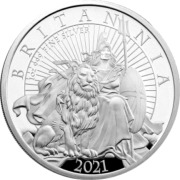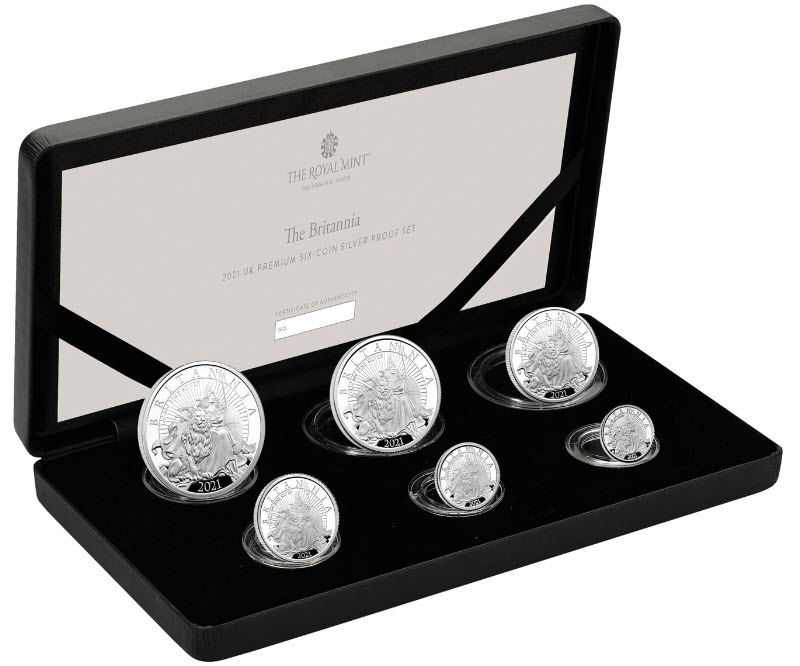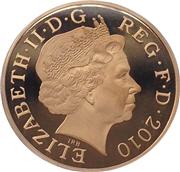 The 2021 Silver Britannia - 6-Coin Silver Proof Set
The 2021 Silver Britannia - 6-Coin Silver Proof SetA set of silver Britannia coins from 1 ounce down to one-fortieth ounce. The sets are usually the only way to buy the fractional Silver Britannia coins (some of which are very small!).
 The sets are very popular and tend to sell-out. The limited edition mintage was 1,100.
The sets are very popular and tend to sell-out. The limited edition mintage was 1,100.These coins are available (subject to stock) from the Royal Mint Shop
The images used on the one-ounce (£2) are reproduced across the entire set. The Reverse, by P J Lynch, shows Britannia facing with a Lion prominent in the foreground.
The set, all in 999 Fine Silver with a Proof finish, consists of:
- Britannia 2021 UK One-Ounce Silver Proof Coin (£2, diameter 38.61mm, weight 21.21g).
- Britannia 2021 UK Half-Ounce Silver Proof Coin (£1, 27.00mm, 15.71g)
- Britannia 2021 UK Quarter-Ounce Silver Proof Coin (50p, 22.00mm, 7.86g)
- Britannia 2021 UK Tenth-Ounce Silver Proof Coin (20p, 16.50mm, 3.15g)
- Britannia 2021 UK Twentieth-Ounce Silver Proof Coin (10p, 12.00mm, 1.58g)
- Britannia 2021 UK Fortieth-Ounce Silver Proof Coin (5p, 8.00mm, 0.80g)

Image Credit: The Royal Mint.
Mintage: 1,100 (may include coins in sets)
Minted at The Royal Mint
Below are some coins currently being offered on eBay. As an eBay Partner, We may be compensated if you make a purchase.
 Queen Elizabeth II was the longest reigning British Monarch ever, reigning for over 70 years. Born on 21 April 1926 to King George VI and Elizabeth Bowes-Lyon, she became Queen in 1952 and her Coronation was on 2 June 1953. She died on 8 September 2022. Some coins were released dated 2023.
Queen Elizabeth II was the longest reigning British Monarch ever, reigning for over 70 years. Born on 21 April 1926 to King George VI and Elizabeth Bowes-Lyon, she became Queen in 1952 and her Coronation was on 2 June 1953. She died on 8 September 2022. Some coins were released dated 2023.Queen Elizabeth II issued many coins and was monarch during decimalisation. She married Prince Philip, Duke of Edinburgh in 1947 and had four children. Her eldest son succeeded the throne as King Charles III. House of Windsor.
The Silver Britannia is a silver coin minted in the UK by the Royal Mint. It has a denomination of £2 and generally available both in proof and bullion versions. While the bullion version carries the same reverse over the years, the proof version feature a different design each year, making them very collectable.
This article covers the Silver Britannia, but the coin is also minted in gold and platinum; there is a large family of associated coins. Besides the one-ounce silver coin, the silver family includes Half ounce, One quarter ounce, One tenth ounce, One twentieth ounce and a massive Five ounce coin.
Specifications
The size and silver content of this coin has changed since the coin’s release in 1997.
Originally it was 958 (95.8%) silver (which is known as ‘Britannia Silver’, the rest is usually copper).
Since 2013 the silver coins have followed the modern trend of using pure silver and are now produced with a millesimal fineness of .999 (99.9% silver).
One ounce (1997-2012): diameter 40 mm, (32.454 g).
One ounce (2013-) : diameter 38.61 mm, (31.104 g).
Face value: £2 (GBP)
Most years are also available as proof, although not every year.
Design
Know by this name as an image of Britannia is always on the reverse, the coin has been minted in silver since 1997. The image of the Proof Britannia is changed every year, and odd years see Britannia standing and even years see her sitting.
The image may be different on the proof and Unc versions of the same year; this is especially true after 2013. There are variations to the 1oz coin, we see 5oz, 1/2oz, 1/4oz and smaller; there are gold and platinum variants too. Generally the same year shares the same Britannia design.
Britannia, together with a combination of trident, Union Jack shield and lion are all symbols of Great Britain, devised many centuries ago to signify that Britain ruled the waves (as it did indeed in those days with the most powerful navy in the world). Britannia has been used on several other British coins.
The Obverse is always of Queen Elizabeth II.
Formed in the reign of Alfred the Great about the year 886, during the period 1279-1812 it was generally referred to as The Tower Mint as it was housed at the Tower of London. The Master of The Royal Mint has included famous figures such as Sir Isaac Newton.
Since 2010 it has operated as Royal Mint Ltd, a company owned by HM Treasury, under an exclusive contract to supply all coinage for the UK although it also produces medals and coins for other countries. It is currently located at Llantrisant, Wales.
The orignal coinage was Pounds, Shillings and Pence but since decimalisation on 15 February 1971, it is £1 = 100p, that is One Pound = 100 pence. The coinage of the UK is also a long history, the Royal Mint being established as long ago as 886AD when coins were hammered. Today there is perhaps 30 billion coins in circulation, and many (numismatic) collectors coins and sets are issued frequently in gold, silver and other metals.
As an eBay Partner, We may be compensated if you make a purchase.








